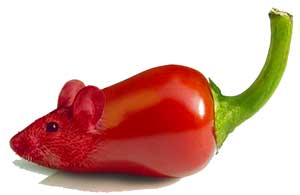“Really? Birds don’t have a sense of smell?” I asked during a Plant and Animal Interactions class in college. My professor was ready for this question. “Nope, and I will explain why. Let’s talk about chili plants and birds”.


Caspsaicin is used in pepper spray
If the purpose of fruit is to be eaten for seed dispersal then why is the fruit of chili plants inedible to a number of organisms? It is due to the chili fruit’s active ingredient known as capsaicin. Capsaicin is an irritant for many animals because it produces a burning sensation in the mouth. Ouch!
 Mammals such as small rodents avoid chiles because they can smell and taste the burning sensation caused by capsaicin. This may in fact be an evolutionary adaptation by the plants to avoid being eaten by mammals because their molar teeth destroy and prevent the seeds from germinating.
Mammals such as small rodents avoid chiles because they can smell and taste the burning sensation caused by capsaicin. This may in fact be an evolutionary adaptation by the plants to avoid being eaten by mammals because their molar teeth destroy and prevent the seeds from germinating.
However, chili fruit acts as a food source for birds. “Wait a second. Why doesn’t it burn their mouth?” My professor explained that birds are unaffected by this chemical due to their lack of smell. Taste and smell are very closely related. Without a sense of smell, taste is limited to only five distinct sensations: sweet, salty, sour, bitter and the newly discovered “umami” or savory sensation. Spiciness is not one of these five distinct categories.
 Unlike mammals, birds eat the seeds but do not fully digest them. The seeds pass through their digestive tract and are dispersed through the bird’s droppings. Since the seeds are not destroyed during digestion they eventually sprout and hopefully grow once they hit the ground.
Unlike mammals, birds eat the seeds but do not fully digest them. The seeds pass through their digestive tract and are dispersed through the bird’s droppings. Since the seeds are not destroyed during digestion they eventually sprout and hopefully grow once they hit the ground.
Natural selection may have led the chili plant to produce more capsaicin because it makes the plant less likely to be eaten by animals that don’t help it reproduce such as small rodents. Many farmers use capsaicin as a natural pest deterrent. Specific targets include voles, deer, rabbits, squirrels, and dogs.
One day my teacher showed up with the candy “Hot Tamales.” Candy during class? It was like we were in elementary school all over again. However, we soon discovered that this was not a free give away. Instead, our teacher wanted to explain to us how taste and smell are related. We were told to plug our noses and eat the candy. I hate spicy things so I was hesitant at first however, my mouth did not catch on fire. I did not even detect the spiciness. Next, we unplugged our noses and ate another candy. My mouth was definitely on fire this time, courtesy of my sense of smell.

This was an awesome class because I had the opportunity to learn about multiple evolutionary adaptations developed between plants and animals in order to make them successfully reproduce. The one that I will always remember however, is between chili peppers and birds. Who could forget getting candy during a college seminar? Of course there was some science behind the candy. Mimicking what sensations a bird versus mammal might experience when eating something spicy was a pretty awesome experiment.
 At High Trails Outdoor Science School, we literally force our instructors to write about elementary outdoor education, teaching outside, learning outside, our dirty classroom (the forest…gosh), environmental science, outdoor science, and all other tree hugging student and kid loving things that keep us engaged, passionate, driven, loving our job, digging our life, and spreading the word to anyone whose attention we can hold for long enough to actually make it through reading this entire sentence. Whew…. www.dirtyclassroom.com
At High Trails Outdoor Science School, we literally force our instructors to write about elementary outdoor education, teaching outside, learning outside, our dirty classroom (the forest…gosh), environmental science, outdoor science, and all other tree hugging student and kid loving things that keep us engaged, passionate, driven, loving our job, digging our life, and spreading the word to anyone whose attention we can hold for long enough to actually make it through reading this entire sentence. Whew…. www.dirtyclassroom.com

Comments are closed.